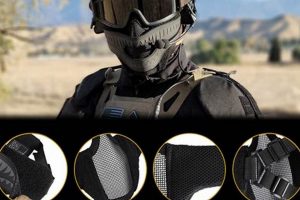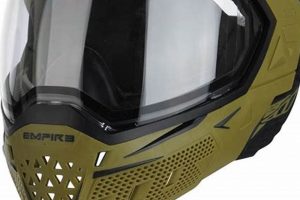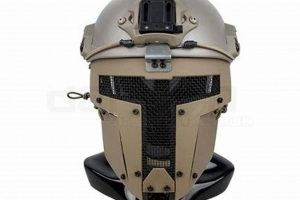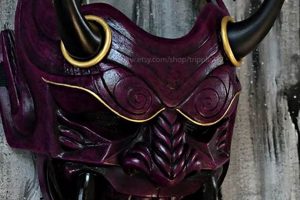Protective headgear designed for the sport of airsoft often incorporates a facial covering shaped to resemble the skeletal structure of a skull. This type of equipment provides protection to the face and head during airsoft gameplay, while also offering a visually striking aesthetic. As an example, a full-face shield molded to mimic a cranium is a frequently encountered variation.
The utilization of such designs serves multiple purposes. Primarily, it enhances player safety by mitigating the risk of injury from projectiles. Secondarily, it allows for individual expression and customization within the airsoft community. Historically, the adoption of intimidating visual elements is observed across various tactical and recreational activities, reflecting a desire to project a specific image.
The subsequent sections will examine specific considerations regarding the construction materials, safety standards, and diverse styles available in this category of airsoft equipment. Furthermore, this article will delve into the practical aspects of selecting appropriate protective gear for optimal performance and player well-being.
Selection and Maintenance Guidance
The following guidance provides insights into the proper selection, use, and maintenance of protective headgear featuring cranial design elements for airsoft activities. Adherence to these recommendations promotes both safety and longevity of the equipment.
Tip 1: Material Evaluation: Prioritize impact-resistant polymers, such as ABS plastic or reinforced nylon, for robust protection. The chosen material should withstand the force of standard airsoft projectiles without fracturing.
Tip 2: Ventilation Assessment: Adequate airflow is crucial to prevent fogging and maintain player comfort. Examine the ventilation design; consider models incorporating multiple vent ports or integrated fan systems.
Tip 3: Lens Quality Inspection: Opt for lenses rated to meet or exceed ANSI Z87.1 standards for impact resistance. Ensure the lens provides clear vision and is free from distortions or blemishes.
Tip 4: Secure Fastening Systems: Verify the retention system is robust and adjustable, ensuring a secure and stable fit. This minimizes the risk of displacement during dynamic movement.
Tip 5: Proper Cleaning Protocols: Clean the exterior surface with mild soap and water, avoiding abrasive cleaners that may damage the finish. Lens cleaning should be performed using microfiber cloths to prevent scratching.
Tip 6: Regular Damage Assessment: Conduct routine inspections for cracks, fractures, or loose components. Any detected damage compromises protective capabilities and necessitates replacement.
Tip 7: Storage Considerations: Store the equipment in a cool, dry environment away from direct sunlight. This prevents degradation of the materials and maintains structural integrity.
Following these guidelines ensures proper utilization and extended service life. Prioritizing safety and conscientious maintenance are paramount when using this protective equipment.
The subsequent section will cover common modifications and customization options available for this specific type of protective headgear, further addressing player needs and preferences.
1. Protection
The primary function of headgear featuring cranial designs within the context of airsoft is to provide protection to the wearer’s face and head. The effectiveness of this protection is directly correlated to the material composition, design, and manufacturing standards adhered to during its production. A demonstrable example of this is the difference between injection-molded high-density polymer models versus thinner, less resilient alternatives. The former provides significantly greater resistance to projectile impact, thus reducing the likelihood of injury. Compromised protective qualities directly undermine the user’s safety during airsoft activities, rendering aesthetic appeal irrelevant.
The level of protection offered also dictates the acceptable engagement range during gameplay. Headgear certified to meet specific impact resistance standards, such as ANSI Z87.1, permits closer engagements than those lacking such certification. Real-world incidents involving substandard protective equipment have resulted in facial fractures, eye injuries, and concussions, highlighting the critical importance of verifiable protection. Understanding the relationship between material properties, certification standards, and the potential for injury is paramount to selecting appropriate gear.
In summary, “Protection” is not merely a feature, but the defining purpose of facial coverings employed in airsoft. The effectiveness of this “Protection” directly influences player safety and the parameters within which gameplay can safely occur. Challenges remain in ensuring consistent adherence to safety standards across all manufacturers and in educating consumers on the importance of verified protective capabilities. Ultimately, prioritizing safety is paramount for responsible participation.
2. Material
The material composition of facial coverings mirroring cranial structures in airsoft directly dictates its protective capability and durability. High-density polymers, such as acrylonitrile butadiene styrene (ABS) or fiber-reinforced nylon, are commonly employed for their impact resistance. The choice of material influences the equipment’s ability to withstand projectile impacts at varying velocities. Inferior materials, like thin, non-reinforced plastics, are prone to shattering upon impact, rendering them ineffective. For example, a model crafted from injection-molded polycarbonate exhibits significantly higher shatter resistance than a vacuum-formed PVC variant.
Furthermore, the material impacts user comfort and longevity. Well-ventilated designs utilizing breathable materials, such as mesh inserts or strategically placed perforations, mitigate fogging and reduce heat buildup. Models incorporating flexible polymers in areas like cheek pads enhance comfort during prolonged use. The selection of materials also influences the weight of the equipment; lighter materials, while potentially compromising impact resistance to some degree, reduce fatigue during extended periods of activity. Conversely, more robust materials add weight but provide a higher degree of protection. The material also affects ease of maintenance. Some materials are more resistant to scratches, and certain polymers may degrade under exposure to UV radiation or specific cleaning agents.
In conclusion, material selection is a critical factor in the overall performance and safety offered by airsoft headgear resembling skulls. The material directly dictates impact resistance, comfort, weight, and longevity. Responsible selection entails a thorough understanding of material properties and their implications for both player safety and the lifespan of the equipment. Challenges remain in standardizing testing methodologies and clearly communicating material specifications to consumers. The ultimate goal is to ensure that individuals make informed purchasing decisions based on verifiable data, enabling them to prioritize safety during airsoft gameplay.
3. Ventilation
Ventilation is a critical design parameter for protective headgear used in airsoft, particularly models featuring full-face coverage and skull-like aesthetics. The enclosed nature of such equipment inherently restricts airflow, leading to heat buildup and moisture accumulation from perspiration. This, in turn, results in lens fogging, significantly impairing vision and negatively affecting player performance and safety. Insufficient ventilation compromises the user’s ability to accurately perceive the surrounding environment, hindering reaction time and increasing the risk of accidental collisions or injury from incoming projectiles. As a practical example, a closed-off, solid-cast skull design lacking strategic venting would quickly become unusable in warm or humid conditions due to fogging and discomfort.
Effective ventilation systems typically incorporate multiple strategically positioned vents to promote airflow without compromising protective coverage. These vents may be located around the mouth, nose, and forehead areas. Some advanced designs feature integrated miniature fans to actively circulate air within the enclosure, further mitigating fogging and heat buildup. The effectiveness of a ventilation system can be assessed by observing the speed at which moisture dissipates from the lens surface under simulated gameplay conditions. Another important consideration is the balance between ventilation and projectile ingress. Vent designs must prevent the entry of airsoft BBs while allowing adequate airflow. Modifying existing ventilation systems without careful consideration can compromise the protective integrity of the headgear.
In summary, adequate ventilation is an indispensable component of functional and safe airsoft protective headgear exhibiting cranial designs. Insufficient ventilation leads to impaired vision, reduced comfort, and heightened risk of injury. The integration of strategically placed vents or active cooling systems is essential to maintaining optimal performance and user safety. Challenges persist in designing ventilation systems that effectively balance airflow with projectile protection, requiring careful engineering and material selection. Prioritizing ventilation, alongside impact resistance and overall design, is crucial for responsible equipment selection within the airsoft community.
4. Fit
The proper fit of protective headgear, specifically models incorporating skull-like designs used in airsoft, is paramount for ensuring both safety and functionality. A poorly fitted piece of equipment compromises protective capabilities and hinders player performance.
- Secure Positioning and Retention
A correctly fitted head covering remains securely positioned on the user’s head throughout dynamic movements inherent in airsoft gameplay. Ill-fitting models are prone to shifting or dislodging upon impact or during rapid maneuvers, exposing vulnerable areas of the face and head to potential injury. A robust retention system, including adjustable straps and padding, is essential for achieving a secure and stable fit. For example, a mask without adequate adjustment may slide backward during sprinting, leaving the chin unprotected.
- Comfort and Prolonged Wear
Proper fit directly influences user comfort during extended gameplay sessions. A mask that is too tight can cause pressure points, leading to discomfort and potential headaches. Conversely, an overly loose mask may chafe or move excessively, causing distractions and hindering performance. The internal padding and contours should conform to the user’s facial structure, distributing pressure evenly and minimizing discomfort. For instance, insufficient padding around the nose bridge can result in pinching and discomfort during prolonged use.
- Integration with Eye Protection
Compatibility with eye protection is a critical aspect of fit. The headgear must seamlessly integrate with goggles or other eyewear to prevent gaps that could allow projectiles to enter and cause eye injuries. A secure and flush fit between the mask and eye protection is essential. Some designs incorporate integrated goggle systems to ensure proper alignment and seal. The absence of such integration can lead to dangerous gaps that compromise the user’s safety. An instance would be a poorly fitted mask which pushes goggles up allowing a bb to impact the eye.
- Field of View and Peripheral Vision
The fit of the mask influences the user’s field of view and peripheral vision. An improperly fitted mask can obstruct the user’s vision, limiting situational awareness and increasing the risk of collisions or being caught off guard by opponents. The design and positioning of the mask’s eye openings should maximize visibility while maintaining adequate protection. For example, a design with narrow eye slits may restrict peripheral vision, making it difficult to spot flanking maneuvers.
These facets underscore the vital connection between proper fit and the overall effectiveness of protective headgear employed in airsoft. Neglecting fit considerations compromises user safety and hinders performance. A well-fitted airsoft mask incorporating a skull design maximizes protection, comfort, and situational awareness, enabling responsible participation in the sport.
5. Vision
Optical clarity and unobstructed sightlines are critical attributes of any protective facial covering used in airsoft, particularly those featuring skull-like designs. The design and construction of these masks directly influence a player’s ability to perceive the surrounding environment, identify targets, and react to threats. Compromised vision due to poorly designed eye openings, fogged lenses, or distorted materials negates the protective benefits of the equipment. For example, narrow eye slits in a skull mask may severely restrict peripheral vision, making it difficult to detect flanking maneuvers or approaching players. Similarly, the use of low-quality plastic lenses can introduce optical distortion, leading to inaccurate depth perception and impaired target acquisition. Instances exist where inadequate vision resulted in misidentification of allies or failure to react to incoming projectiles, underscoring the practical significance of uncompromised sight.
The relationship between vision and head protection extends beyond mere optical clarity. The positioning and angle of the eye openings also influence the range of vertical and horizontal vision. The design should accommodate a wide field of view, allowing players to maintain situational awareness without excessive head movements. Furthermore, the lens material must provide adequate protection against projectile impacts while minimizing glare and reflections. Tinted or polarized lenses may be advantageous in certain lighting conditions, but their suitability depends on the specific playing environment. The integration of anti-fog coatings is also essential for maintaining clear vision in humid or high-intensity gameplay scenarios. Without these considerations, the intended protective functionality may be significantly diminished, resulting in an unsafe playing experience.
In conclusion, visual acuity is inextricably linked to the effectiveness of airsoft headgear mimicking cranial structures. Designing and selecting equipment that prioritizes a clear, unobstructed field of view is essential for responsible gameplay and injury prevention. Challenges remain in balancing protective integrity with optimal vision, particularly in designs with intricate or stylized aesthetics. Prioritizing visual clarity, lens quality, and anti-fog capabilities remains paramount for ensuring user safety and performance on the airsoft field. The responsibility lies with both manufacturers and consumers to uphold rigorous standards regarding vision-related aspects of protective gear.
6. Durability
The operational lifespan of protective headgear employed in airsoft, specifically those featuring a cranial aesthetic, is directly contingent upon its structural integrity and resistance to degradation under operational stresses. The inherent impact forces involved in airsoft gameplay, combined with environmental factors such as UV exposure and temperature fluctuations, contribute to the gradual wear and tear of these devices. Inferior materials or substandard manufacturing processes diminish the product’s ability to withstand repeated impacts from projectiles, leading to premature failure and compromised player safety. For instance, a skull-shaped mask constructed from thin, low-grade plastic is prone to cracking or shattering upon impact, necessitating frequent replacements and exposing the wearer to potential injury. The practical significance of robust construction is underscored by instances where poorly made protective gear has failed during gameplay, resulting in facial injuries that could have been prevented by equipment with enhanced durability.
Material composition plays a crucial role in determining the durability of the headgear. High-density polymers, such as reinforced nylon or polycarbonate, offer superior impact resistance and dimensional stability compared to softer or more brittle plastics. The implementation of appropriate reinforcing techniques, such as internal ribbing or layered construction, further enhances the structural integrity of the device. Moreover, the integration of UV-resistant coatings mitigates the degrading effects of sunlight exposure, prolonging the operational life of the product. Practical applications of these considerations include selecting masks certified to meet or exceed relevant safety standards, such as ANSI Z87.1, which mandates specific impact resistance requirements. Furthermore, regular inspection and maintenance, including cleaning with appropriate solvents and storing the gear in a temperature-controlled environment, can contribute to extending its lifespan. The economic implications of selecting more durable options are considerable; although the initial investment may be higher, the reduced frequency of replacements ultimately lowers the total cost of ownership.
In summary, durability is an essential attribute of protective airsoft headgear featuring cranial designs, directly influencing its operational lifespan, safety performance, and overall cost-effectiveness. A failure to prioritize robust construction and appropriate materials results in compromised player protection and increased expenditure on replacement equipment. Addressing the challenges of ensuring consistent quality across manufacturers and educating consumers on the importance of durable design is crucial for promoting responsible participation in the sport. The link between informed purchasing decisions and enhanced player safety is undeniable; therefore, a comprehensive understanding of material properties, construction techniques, and relevant safety standards is paramount.
Frequently Asked Questions
This section addresses common inquiries regarding protective face gear designed for airsoft, exhibiting skeletal aesthetics. It provides clarity on safety, compatibility, and maintenance.
Question 1: Are skull-designed airsoft masks universally safe for all players?
The safety of such equipment hinges on adherence to recognized safety standards (e.g., ANSI Z87.1) and the integrity of the materials used in construction. Masks lacking certification or constructed from substandard materials pose a significant safety risk, irrespective of the aesthetic design.
Question 2: How does the skeletal design impact field of vision?
The design of the eye apertures is critical. Narrow or poorly positioned openings can severely restrict peripheral vision, impacting situational awareness. Optimal designs maximize the field of view without compromising impact protection.
Question 3: What materials are best suited for providing adequate protection in skull airsoft masks?
High-density polymers, such as polycarbonate or reinforced nylon, offer superior impact resistance compared to thinner, less durable materials. The chosen material should withstand repeated impacts from airsoft projectiles without fracturing or shattering.
Question 4: How can fogging be mitigated in full-face skull designs?
Effective ventilation is crucial. Features such as strategically placed vents, anti-fog coatings, or integrated miniature fans can significantly reduce fogging and maintain clear vision during gameplay.
Question 5: Are modifications to skull airsoft masks recommended?
Modifications that compromise the structural integrity or protective capabilities of the mask are strongly discouraged. Alterations should only be performed with careful consideration of safety implications and in accordance with manufacturer guidelines.
Question 6: What cleaning and maintenance procedures are appropriate for these masks?
Clean the exterior surface with mild soap and water. Abrasive cleaners should be avoided. Lens cleaning requires microfiber cloths to prevent scratching. Regular inspection for damage is essential; any detected damage necessitates immediate replacement.
Selecting appropriate head protection is paramount. Consider these factors to mitigate risks associated with gameplay.
The subsequent section explores advanced technologies applicable to protective headgear. This will include innovative materials and integrated systems.
Airsoft Mask Skull
This exploration has underscored critical facets of protective headgear resembling skeletal structures used in airsoft. Material selection, ventilation efficacy, fit precision, vision clarity, and long-term durability each exert a significant influence on user safety and performance. The integration of these elements determines the functional value of the equipment, impacting the user’s protection against potential injury during gameplay.
Prioritizing verified protective capabilities and responsible equipment selection is paramount. The airsoft community should insist upon verifiable testing standards and transparent manufacturing processes. Continued research and development efforts should focus on innovative materials and designs that maximize both protection and comfort, ensuring a safer and more enjoyable experience for all participants. Adherence to these principles will define the future of protective gear in the airsoft community.


![Top-Rated: Best Full Face Mask for Airsoft [2024 Guide] Ultimate Airsoft Guide for Beginners, Tactics & Gear Reviews Top-Rated: Best Full Face Mask for Airsoft [2024 Guide] | Ultimate Airsoft Guide for Beginners, Tactics & Gear Reviews](https://airsoftica.com/wp-content/uploads/2025/12/th-52-300x200.jpg)




